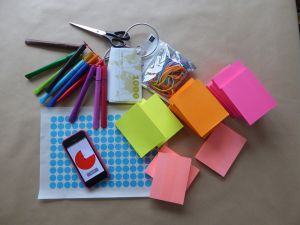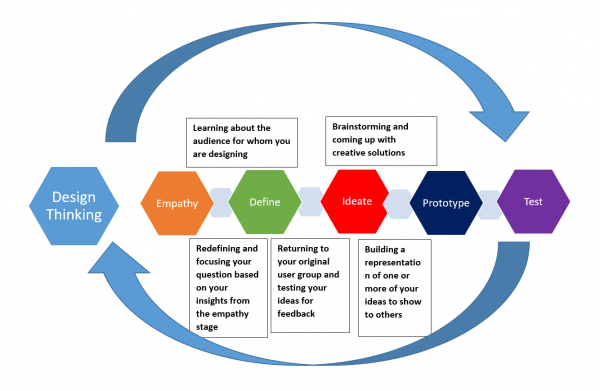Design Thinking
| Type | Team Size | ||||||
|---|---|---|---|---|---|---|---|
| Collaborative Tools | Software | Personal Skills | Productivity Tools | 1 | 2-10 | 11-30 | 30+ |
In short: Design Thinking is a process for creative problem solving and innovation which focuses on understanding the target user and which differs from other creative problem-solving processes by developing and testing prototypes of potential solutions.
What, Why & When
- Design Thinking is a creative process in product or service design with a user-centered perspective. It helps empathise with others, understand their perspectives and develop solutions to their problems. This way, it prevents you from creating a solution when there is no problem.
- Disclaimer: Design Thinking does not necessarily help you to compromise and balance different interests on the same resource e.g. clean air.
- It is an iterative process of brainstorming, persona building, prototyping and testing. A Design Thinking team should not be larger than five individuals, but several teams can work on the same problem at once. The length of the process is expandable (up to a week), but may also be squeezed into a 3-hour workshop
Getting started
Material
First, you have to decide under which conditions you want to host a Design Thinking session. What is the topic or the problem you want to work on? Which participants, perspectives and skills do you need to go through the process? It is recommendable to not work in larger groups than five, if you are more participants, you can split up in smaller teams and find out with what kind of solutions you come up with. Define a workshop facilitator who guides the process, and create an agenda. Find a room and organize the material and resources that you need (paper, pen, post-its, whiteboard etc.)
Second, you need to communicate what you expect from the participants: Time, energy, attention. Try to make use that every participant is actually committed as one team member less is easier to work with than somebody dropping in and out.
The Process
Empathise
In the first phase of the process, you try to change your perspective from your own to the user that you want to focus on. Define your target/ user group and research about their background. You can make use of persona building to visualize your target group. A look into demographics can be of help to understand the specific situation of your target group. Maybe you'll also want to have a look at the SINUS group approach. Do all you can to understand the life that your target group is living. Your goal is to be able to think and feel like the person or group of persons you want to empathize with.
Define
In the second step, you want to define your problem from the perspective of the user. What are the needs and wishes? What are their daily problems? Where do they need help?
Ideate
This is the wild phase of Design Thinking. You throw all ideas you have into the discussion, for which you can use different methods such as brainstorming, brainwriting, a written discussion, who-writes-the-most-ideas-on-post-its and more. The goal is to broaden your view - no idea is too big or too far out of the box. Everything is allowed at this point, no matter how unrealistic it seems. Don't restrict yourself, this comes later. Try to challenge general assumptions - this leads to the best, unforeseen solutions.
Prototype
Now you are allowed to criticise. The goal of this phase is to identify one solution out of the many that seems to be most promising, and design a prototype for it. Decide on the solution as a group, and weigh all your options. Why do you think this option seems to be the best? What makes it stand out? Why and how does it best address your target groups needs? The prototype can take any form or shape, it can be a drawing, a mock-up of an application, a framework, a staged situation - anything that helps you visualize and communicate your solution quickly to anyone. It should be understandable and not be too detailled yet.
Test
In this final phase, you try to get feedback from the user group. The feedback should come from 'real' users - so you can call your colleagues, friends, ask people on the street or even reach out to people who might actually be your target group. You need to collect reactions on your prototype. After that, depending on the feedback, you iterate and get back to another earlier step in the process. If your users mirror you that your prototype is far from what is needed, you should start at understanding your user group again. If only little tweaks are missing, you can work on your prototype some more and test it again more quickly. As soon as their are only minor critical comments from your target group, you are ready to realize the solution.
Rules
-
Yes, and: The rule of "yes-and" means, that you should try to build up on each others ideas. Even though you have the impression that the suggestion by your team member is not suitable, add something that makes it fitting
-
Quantity first, quality second - first storm, then criticise: Not everything that is brought up in the process will be the next big thing. Try to not judge ideas and collect everything at first. You can throw out unnecessary stuff later.
-
Keep the target in mind: As it happens fast that you get carried away by the brainstorm-thunder, try to get back to the problem description multiple times and check whether your solution fits to the problem and target group. This helps you to stay on track and adjust if necessary.
-
Work as one group: You might have the impression that your idea is better than the other one. Try to focus on one idea with the whole group and do not start to do your own thing. Use the attention of the whole group to progress.
-
Be visual: Depending on your preference, you can draw an idea, make a mindmap, write everything on post-its or use a written discussion - the most important aspect is: write it down. Therefore, you will have a written documentation later and can get back to ideas that were brought up hours ago.
An example for sustainability science
Imagine you want to find solutions for different stakeholders on land use in the city of Lüneburg.
- At first, you would need to define the different needs of the stakeholder and cluster them into need groups, e.g. all stakeholders that are interested in climate change mitigation aspects.
- Then, you would assign one team per need group and let them dive into the process. The process steps are still the same for all of the groups.
- After having finished the process, you can compare the different solutions. One group might have come up with a participation format of how to include a group that is not yet involved in a decision process. Another group might have developed a ranking scheme for decision criteria and so on. Now, you can see whether there are similarities between the different solutions and how they can be combined, transferred to another need group.
Links & Further reading
-
https://hpi.de/en/school-of-design-thinking/design-thinking/background/design-thinking-principles.html
- Tips for organizing design thinking sessions: https://newkind.com/12-design-thinking-rules-from-david-burney/
- Conference Paper on Design Thinking Methods: https://link.springer.com/chapter/10.1007/978-3-319-20886-2_2
- Youtube Video about Design Thinking principles (very entrepreneurial): https://www.youtube.com/watch?v=gHGN6hs2gZY
The author of this entry is Alexa Böckel.

